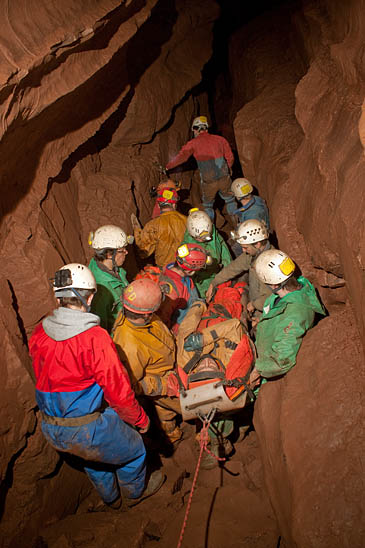A rescue team has described one of its most difficult rescues of a man trapped for seven hours underground.
The 43-year-old caver became firmly wedged after falling in the Labyrinth area of the Ogof Ffynon Ddu II system in south Wales.
The South & Mid Wales Cave Rescue Team was alerted to the incident in the cave near Penwyllt after the man fell in a rift underground.
Team spokesman Piers Hallihan said: “This resulted in his pelvis being lodged below a constriction in the rift.
“He tried to move along the rift to find a spot where he could get out, but simply ended up being completely wedged by his pelvis.
“His arms, legs, body and head were all free to move, but he had no way to support his weight other than on his pelvis. His right leg was awkwardly twisted and his right arm bent over his head.
“He was with a strong team who tried to help him get free but crucially sent out runners to raise the alarm at any early stage.
“This meant that within an hour of his entrapment the callout was already underway. An Ogof Ffynon Ddu surveying team was passed on the way down the hill and they were redirected to assist.”
Mr Hallihan described how the rescuers first had to stabilise the casualty. “He was understandably very concerned about his predicament,” he said.
“He was also physically a spent force and was struggling to suspend himself in order to relieve his own pain. The reassurance of re-enforcements and specialist equipment started to raise morale.
“Two bolts were immediately placed in the ceiling either side of him. Gri-Gris [a type of belay device] were installed to provide fully adjustable ’stirrups’ for his feet.”
The team then had to set about freeing the trapped caver from the underground rift.
Mr Hallihan said: “Plan A was to attempt to reverse his route into the rift, with the assistance of Entonox [analgesic gas].
“Plan B was to use plugs and feathers to remove the restriction directly restraining his pelvis.”
Plugs and feathers are wedges hammered into rocks to split them.
“It was suggested that plan B would improve morale, so we had a quick go before proceeding with plan A,” Mr Hallihan said.
“Luckily the plugs and feathers worked amazingly well and resulted in a first clean cut and a significant slab of rock removed.
“It was clear that plan B was the way forward. Under these unique circumstances, repeatedly drilling towards his genitals proved to be a massive psychological boost, although on one occasion we did drill his leg.
“Plug and feather cut number two allowed access to make the critical third cut. The pelvis was so tightly wedged that in order to remove the critical pieces of rock, we had to directly lever his pelvis requiring significant amounts of Entonox.”
The next stage was to get the casualty out of the rift. The rescue team spokesman said: “We were now confident that he was free, but by this point he was barely able to feel or move his limbs.
“It was therefore very tricky, in the confined space, to raise him out of the rift. There was less than 40cm [16 inches] between the top of his shoulders and the ceiling, so we had no space for pulleys or proper knots.
“By installing a stemple between the two bolts and tying a sling under his armpits we were able to raise him vertically for the crucial first 10cm, before using brute force to rotate him and drag him out of the rift.
“He was released at 8pm, after being stuck for seven hours.
“Once released he was given a full medical examination, properly rewarmed and given some food and drink to prepare him for the journey out.
“After 30 minutes, and fitted with a full body harness, he was able to stand and, with close support, able to start making his way out. The activity improved his circulation and he quickly picked up speed.
“Two roped sections were pre-rigged and swiftly dispatched. He reached the surface about 10pm with a big grin.”
Mr Hallihan said the caver was finally taken to hospital by ambulance with a suspected trapped nerve in his right arm.
The South & Mid Wales Cave Rescue Team was formerly known as West Brecon Cave Rescue Team and is a member of the British Cave Rescue Council and is one of the 15 UK cave rescue teams.
It is also affiliated to Mountain Rescue England and Wales.
The team has been in existence since 1946 and is formed by around 150 cavers who voluntarily help others who may be lost or injured underground in caves or mines in south and mid-Wales.
The team, based at Penwyllt in the Swansea Valley is called to rescue both people and animals trapped underground.
It maintains a secondary base near Llangattock in Powys which covers the Gwent caves and the team also has a store of specialist mines rescue equipment in mid-Wales.


Tim Barter
06 January 2013Congratulations to the team on both a first rate extraction (rescue), and to the Liz Roberts and this website for a measured, self explanatory and non-exaggerated report. I can't wait to see how this rescue is picked up and reported elsewhere (actually I can and will be fearing the worst of journalistic distortion and exaggeration).